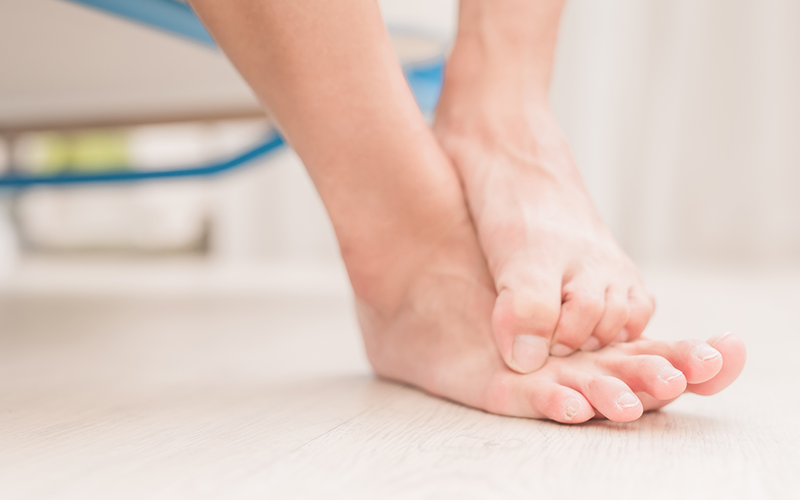Everyone has yeast that naturally lives on his or her skin. This yeast, which is a type of fungus, is harmless unless it grows out of control and leads to an infection.
Fungal skin infections are very common and typically grow on areas of the skin that are moist, like folds in the skin or between the toes. The infection typically lives on the top layer of skin and can be prevented by keeping skin clean and dry. A dermatologist can typically diagnose a fungal skin infection with a simple skin exam or by scraping a small amount of skin from the affected area and examining the scales under a microscope. Most fungal infections are treated with medicated antifungal creams, gels and lotions applied directly to the affected area. These medications can be combined with oral antifungal medications and prescription-strength corticosteroids in some cases.
Here are five of the most common fungal skin infections and how to treat them:
#1: Athlete’s Foot
Athlete’s foot is a very common and contagious fungal infection that affects the skin on the feet. Athlete’s foot usually starts with itching, stinging or burning between the toes and on the soles of the feet and can include blisters and cracked peeling skin.
While anyone can get athlete’s foot, you are more likely to get the infection by keeping your feet wet for long periods of time or walking around barefoot in warm, moist public places such as public showers, locker rooms, and swimming pools. The best way to prevent athlete’s foot is to keep feet clean and dry and to wear flip-flops or other open-toe, breathable shoes in public areas. Using antifungal powder and wearing cotton socks can also help to prevent athlete’s foot.
Athlete’s foot can generally be treated with over-the-counter topical antifungal medications. In more serious cases, prescription strength topical steroid creams, oral antifungal medications, and oral antibiotics may be required.
Related: 5 Common Foot Rashes
#2: Ringworm
Don’t worry — ringworm isn’t actually a worm. It’s a fungal skin infection.
Ringworm can appear anywhere on the skin and looks like a circular red, itchy flat sore or raised scaly patch. Sometimes, the patches will have a defined and red edge. (If you have ringworm in your nails, they may become thick and discolored.) You can have more than one patch of ringworm on the skin and the patches can overlap.
Ringworm can spread by touching another person with the infection, sharing items that an infected person has been in contact with or through animals or even soil.
Ringworm generally responds to over-the-counter topical creams like Lamisil, Monistat-Derm, and Lotrimin. Prescription-strength topical or oral drugs can be prescribed in more severe cases and can be combined with a steroid to alleviate itching.
Preventing ringworm is usually as simple as not sharing towels or clothing with someone who may be infected. You should always wear sandals or flip-flops in locker rooms and other public, wet environments.
#3: Jock Itch
Jock itch is caused by the tinea fungus, which thrives in warm, moist areas of the body such as the genitals, buttocks and inner thighs. Jock itch typically looks like a red, itchy rash and can be ring-shaped with elevated edges. It can also present as a red area of flaking, peeling or cracking skin.
This common skin infection is more prevalent in the summer months and is spread from person to person through direct contact or indirectly through inanimate objects. Treatment includes keeping the affected skin clean and dry and applying over-the-counter topical antifungal medications. Prescription-strength topical medications are sometimes required.
Washing and drying infected skin, applying antifungal powder or creams, and changing clothes and underwear every day also helps to keep the area clean.
#4: Yeast Infections
Yeast infections are noncontagious infections caused by yeast-like fungi called Candida. The infection appears as a red, scaly and itchy rash, pimple-like bumps, or itching and burning sensation. It can affect any area of the body, though it most often occurs in warm, creased areas such as the armpits or groin. Candida also causes diaper rash and vaginal yeast infections. Treatment for yeast infections depends on the kind and location of the infection, but over-the-counter creams and medications are usually effective. Some more severe cases may require an additional oral medication.
#5: Tinea Versicolor
Tinea Versicolor, also called pityriasis versicolor, is a very common fungal skin infection that is found in tropical climates. The yeast that causes this infection thrives in hot, humid weather and on sweaty and oily skin.
The infection begins as spots on the skin that can appear lighter or darker than surrounding skin and can pop up anywhere on the body. The affected area can become itchy and typically grows and spreads slowly. Treatment includes antifungal topical medications in combination with medicated cleaners in some cases.
Looking to Visit a Dermatologist?
Are you experiencing symptoms of a fungal skin infection? To learn more, contact U.S. Dermatology Partners today to make an appointment with one of our board-certified dermatologists. We have multiple locations throughout the country, so fill out our simple online form to get in touch with us. One of our local team members will reach out to you shortly to answer your questions or schedule an appointment for you to visit us soon.
Find a location near me
or

